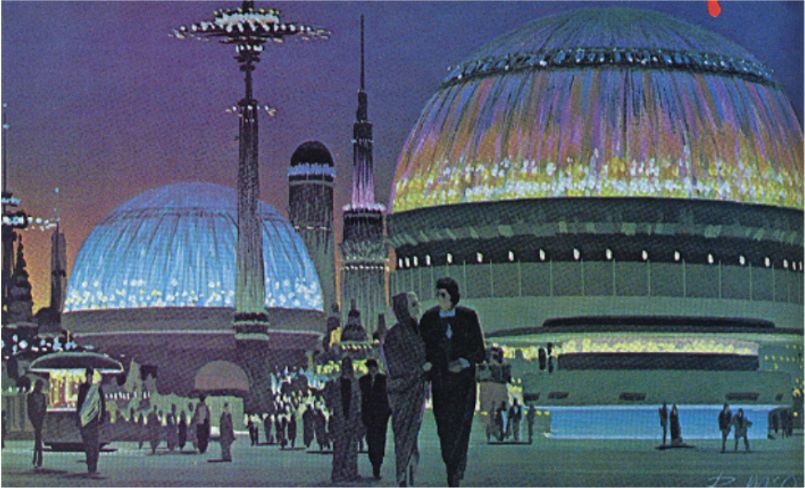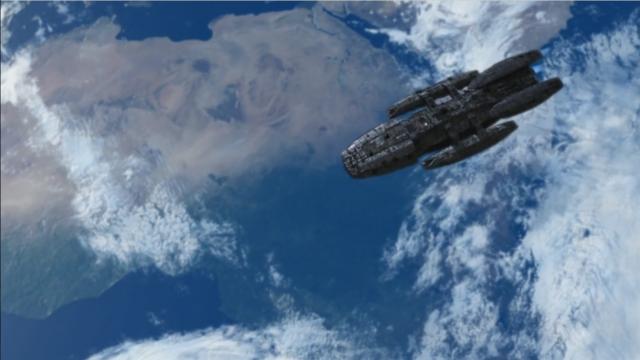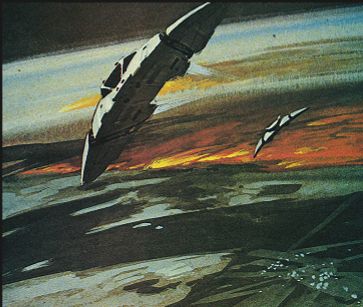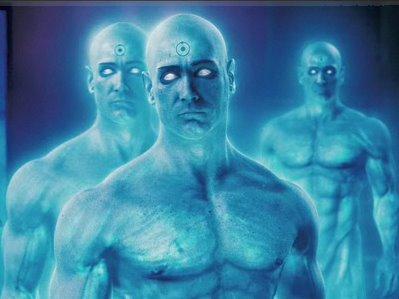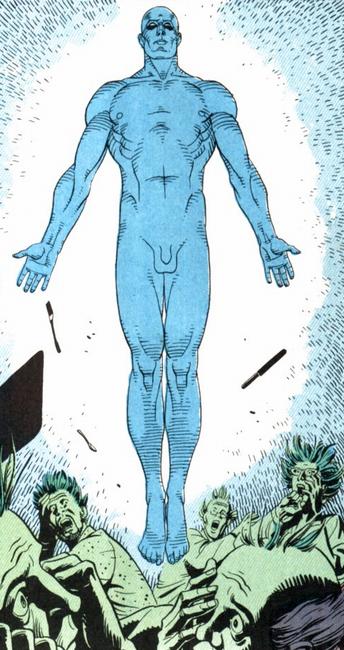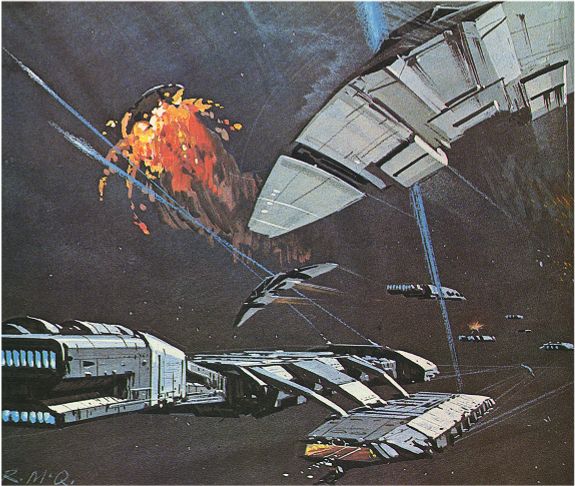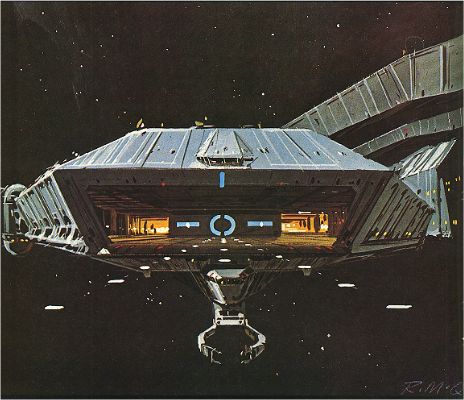Finishing the first week of a new school term always leaves me feeling as though I’ve launched some kind of ship — like I’ve broken a bottle of bubbly against the side of a vessel that then rolls proudly out of drydock. (Not that I’ve ever performed this particular action in real life. Like so many of my mental referents, it’s a composite of media memories: scenes from movies like Titanic, or the wonderful, ballsy opening shots of Star Trek: Generations, in which a champagne bottle tumbles through space to smash across the prow of the Enterprise-B.)
In this case, we’re talking two inaugural voyages: the first, a retooled version of my Animation and Cinema class, and the second, an entirely new course called Conspiracy. I’ll detail the Animation rethink in a future post, but for now, I want to share the Conspiracy syllabus, which I’m pretty proud of. Putting it together was a pleasurable summer’s labor: I watched dozens of movies, read reams of articles, and basically dug deep into the viny undergrowth of suspicion and speculation that anchors the U.S. political system (or at least our collective perceptions of it). The original inspiration for the class was simply my love of The Parallax View (Alan J. Pakula, 1974), which seemed marvelously strange and icily labyrinthine when I first watched it in the early 1980s. It, along with Phil Kaufman’s remake of Invasion of the Body Snatchers (1978), Peter Hyams’s burnt-sienna cheese platter Capricorn One (1978), and Sydney Pollack’s 1975 film Three Days of the Condor (which has not aged well, sad to say) still exerts a special hold on my imagination, and I’m thrilled at the opportunity to explore it and other texts with a class of talented students.
What’s odd, of course, is that what once seemed in the fantastic sweep of its paranoia to be a close cousin of science fiction — indeed, in movies like Capricorn One and Coma (1978), the generic boundaries dissolve almost entirely — today comes across as naive, obvious, or both. Conspiracy narratives in the 1970s were like hushed whispers of a truth too terrible to dredge into daylight, yet too destructive to ignore; now our ears are deafened by the angry bellows of right-wing pundits, angry town-hall protesters, and certain Republican party leaders who believe our President is a socialist, that health-care reform involves the instigation of death panels, and that vaccinations cause disease. Those who aren’t actively enraged are cynically passive: why fight the system when it’s already become, Matrix-like, the fabric of everyday life? As with another topic I teach, fandom, the cultural polarities of conspiracy seem to have reversed themselves over recent decades: subculture becoming superculture, margin becoming mainstream. And if fandom is by and large about the production of pleasure within convection currents that link fringe and center, then conspiracy, following similar fluid dynamics, generates a darker miasma of dread and distrust.
The syllabus that follows is built around two topoi: the assassination of John F. Kennedy anchors the first half of the semester, the events of 9/11 the second. I’ve tried to address all the major permutations of conspiracy theory in the United States, including supernatural and feminist variations, yet I know there’s much more we could be looking at (and I welcome any suggestions for tweaking the lineup). The fun part has been coming up with a reading list that mixes “authoritative” academic perspectives with raw, disreputable textual troublemakers from the heart of conspiracy country. One of my hopes is that the course will take us from a time when conspiracy seemed an isolatable, nameable, unusual thing to one in which the digital remapping of media culture has multiplied the theories, speculation, and accusation to an unnerving din. Another hope is that students will ultimately come to think self-reflexively about their own practices of textual production and legitimation, and by implication the larger politics of a college education: their place in a system that turns economic capital into cultural capital. And maybe, by the end of the term, this small shared plot, this classroom conspiracy (it tickles me to note that conspire literally means to breathe together — an apt description of our biweekly meetings) will yield, for them and for me, some major insights.
———————————————————————-
FMST 43: Conspiracy – Fall 2009
This course investigates the texts, narratives, and cultures of conspiracy as they are constituted in film, television, digital, and print media. We will concentrate less on the “truth” of any given conspiracy than on its popular and public impact and meaning — what it says, or might be saying, about ourselves, our world, and our times. The subject, then, is both conspiracy theory and theories about conspiracy. As this is a Film and Media Studies course, we will also pay attention to factors such as representation, technology, narrative, audience, and industry, and their relationship to both dominant and resistant ideologies.
Our focus is on the half-century dating from the late 1950s to the present, a period that extends from the Red Scare, the assassination of John F. Kennedy, and the Apollo moon landings to Waco, 9/11, and contemporary controversies about Barack Obama’s citizenship and an all-encompassing New World Order. Confining ourselves to the United States, we will explore the ways in which public perceptions of conspiracies spread and evolve through media practices both inside and outside the mainstream, as a mode of education, entertainment, and political activity. Areas we will explore (moving from specific to general) include:
- The tropes, recurring patterns, and characteristic forms of conspiracy
- The role of different media in shaping perceptions and understandings of conspiracies
- The relationship of conspiracy narratives/theories to other media modes such as journalism and documentary, and genres such as horror, science fiction, and mystery
- The light shed by conspiracy narratives on the production and legitimization of knowledge
- The possibilities and limits of “diagnosing” conspiratorial trends in relation to specific historical and cultural moments
- Conspiracy theory as an element of democratic discourse, grassroots political movements, and ideological critique
Textbooks & Readings
- The Rough Guide to Conspiracy Theories. James McConnachie and Robin Tudge. Rough Guides Reference, 2008.
- Conspiracy Theories: Secrecy and Power in American Culture. Mark Fenster. Revised and Updated Edition. Minneapolis: University of Minnesota Press, 2008.
- Additional readings marked [PDF] will be distributed via Blackboard.
Assignments
15% —Participation: assessed throughout term; for more, see note below.
25% —Activity on class blog: will be assessed three times during term for frequency and content of contributions. For more, see blogging handout.
25% —Midterm paper: due October 8, this 5-7 page paper will respond to the first half of the term by locating a pattern, theme, or idea that ties together a group of conspiracy materials (visual, written, or other). These texts should include both academic and nonacademic content we have looked at together in class, along with material you have explored on your own. In addition to identifying and defining a unifying element, the paper must make some kind of interpretive argument about its significance.
35% —Conspiracy wall display and reflection paper: due the penultimate week of class, this project represents the culmination of your experiences in and thinking about Conspiracy. Working in teams, you will create a public display at McCabe Library, a “conspiracy wall” of texts and images mapping out an existing conspiracy or one of your own design. You will also turn in a 3-5 page reflection paper that discusses the conspiracy and the presentation you have given it. Further details will be given later in term.
A Note on Materials and Methods
In this course we will explore a range of content from different points on the cultural spectrum, from academic articles to photocopied screeds and angry websites, from Hollywood blockbusters to digitally-shot and -distributed underground video. Navigating this material will mean paying attention to origins and rhetorical stance (i.e. where it’s from and what it’s saying) while simultaneously setting aside too-quick distinctions between true/false, logical/illogical, legitimate/illegitimate. While I don’t want to lose sight of “common sense,” I also don’t want the course to devolve into arguments about who really shot JFK. Our assumption will be that we can dabble in conspiracies and conspiracy theories without buying into them — or their counterarguments.
CALENDAR
Week 1 (Sept 1-3): Course Introduction; Types of Knowledge
Read for Thursday: Fenster, “Introduction: We’re All Conspiracy Theorists Now”; Birchall, “Know It All” [PDF], Lisker, “The MADE Manifesto” [PDF]
Screen: Conspiracy Theory (Richard Donner, 1997)
Week 2 (Sept 8-10): Reading and Paranoia
Read for Tuesday: Shapiro, “Paranoid Style”; for Thursday, Fenster Ch 4, “Uncovering the Plot” (pp. 100-117)
Screen: The Game (David Fincher, 1997)
Week 3 (Sept 15-17): Red Scares and Pod People
Read for Tuesday: Fenster, Ch 1 “Theorizing Conspiracy Politics,” Hofstadter, “The Paranoid Style in American Politics” [PDF]; for Thursday, Steffen-Fluhr, “Women and the Inner Game of Don Siegel’s Invasion of the Body Snatchers“?[PDF]
Screen: Invasion of the Body Snatchers (Don Siegel, 1956)
Week 4 (Sept 22-24): JFK
Read for Tuesday: Marcus, excerpts from “The Manchurian Candidate“?[PDF]; for Thursday, Fenster Ch 4 “Uncovering the Plot” pp. 118-142, Simon, “The Zapruder Film” and “JFK” [PDF]; Hidell, “The Center of the Labyrinth” [PDF]
Screen: JFK (Oliver Stone, 1991). Watch on own time before Tuesday’s class: The Manchurian Candidate (John Frankenheimer, 1962).
Week 5 (Sept 29-Oct 1): The Seventies
Read for Tuesday: Kael, “Invasion of the Body Snatchers” [PDF]; for Thursday, Simon, “The Parallax View” [PDF], “Project Mind Kontrol” [PDF]; Hidell, “Who Killed John Lennon?” [PDF]
Screen: The Parallax View (Alan J. Pakula, 1974). Watch on own time before Tuesday’s class: Invasion of the Body Snatchers (Philip Kaufman, 1978)
Week 6 (Oct 6-8): Feminism and Other Science Fictions
Read: Tiptree, “The Women Men Don’t See” [PDF], Valerius, “Rosemary’s Baby, Gothic Pregnancy, and Fetal Subjects” [PDF]; Hidell, “Is There a Satanic Child Abuse Cover-Up?” [PDF]
Screen: Rosemary’s Baby (Roman Polanski, 1968). Watch on own time before Tuesday’s class: The Stepford Wives (Bryan Forbes, 1975)
Due: Midterm paper
Fall Break
Week 7 (Oct 20-22): Space Invaders I
Read: Fenster Ch 5, “Plotting the Rush”; Bara, “The Secret History of NASA” [PDF]
Screen: Excerpt from Capricorn One (Peter Hyams, 1978), A Funny Thing Happened on the Way to the Moon (Bart Sibrel, 2001), Astronauts Gone Wild (Bart Sibrel, 2004). Watch on own time: Mythbusters, “NASA Moon Landing Hoax”
Week 8 (Oct 27-29): Space Invaders II
Read: Fenster Ch 4, “Uncovering the Plot” pp. 143-end; Graham, “Are You Now or Have You Ever Been? Conspiracy Theory and The X-Files” [PDF]; Bell and Bennion-Nixon, “The Popular Culture of Conspiracy/The Conspiracy of Popular Culture” [PDF]
Screen: Episodes of The X-Files TBA; Conspiracy, “Area 51”
Week 9 (Nov 3-5): Politics and Race in the Digital Era
Read: Fenster Ch 3, “Finding the Plot” (review material on Clinton); Knight, “Fear of a Black Planet: ‘Black Paranoia’ and the Aesthetics of Conspiracy” [PDF]
Screen: The Clinton Chronicles (Patrick Matrisciana, 1994); watch on own time The Obama Deception (Alex Jones, 2009)
Week 10 (Nov 10-12): New World Orders
Read: Fenster Ch 2, “When the Senator Met the Commander”; Heimbichner, “The Idiot’s Guide to the Cryptocracy” [PDF]; Weidner, “The Culling: A Speculative Look into the Global Apocalypse” [PDF]; Weston, “FEMA: Fascist Entity Manipulating America” [PDF]
Screen: Endgame: Blueprint for Global Enslavement (Alex Jones, 2007); watch on own time Waco: The Rules of Engagement (William Gazecki, 1997)
Week 11 (Nov 17-19): 9/11
Read: Fenster Ch 7 “A Failure of Imagination”; Helms, “Lingering Questions about 9/11” [PDF]; Meigs, “Afterword: The Conspiracy Industry” [PDF]
Screen: Loose Change (Dylan Avery, 2007); watch on own time before Tuesday’s class: United 93 (Paul Greengrass, 2006)
Week 12 (Nov 24): Looking Forward to the End of the World
Read: Fenster Ch 6, “The Prophetic Plot”; Marrs, “What Will Happen in 2012?” [PDF]; Wallace, “Four Horses of the Apocalypse: A Color-Coded Key to the Cryptocracy” [PDF]
Screen: TBA
Thursday (Nov 26): Thanksgiving Break
Week 13 (Dec 1-3): Encoding/Decoding History
Screen: The Da Vinci Code (Ron Howard, 2006), National Treasure (Jon Turtletaub, 2004)
Due: Conspiracy Wall displays and reflection papers
Week 14 (Dec 8): Last day of class
Student evaluations

